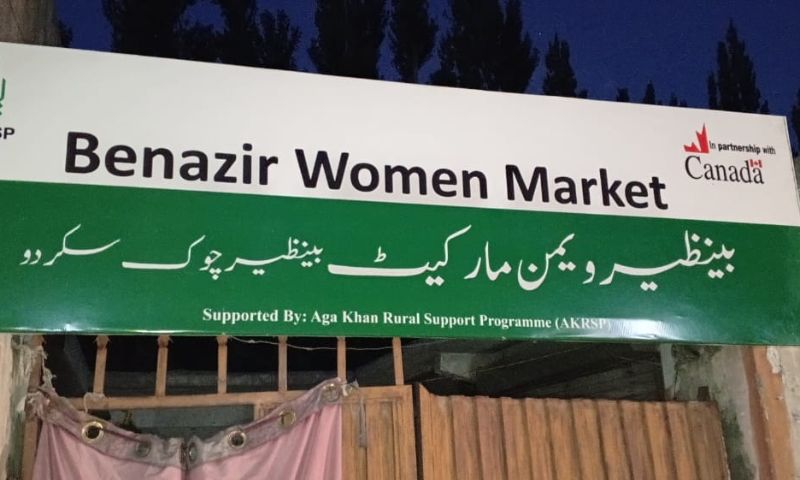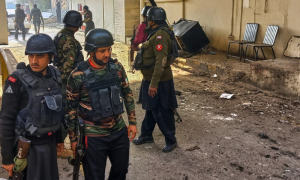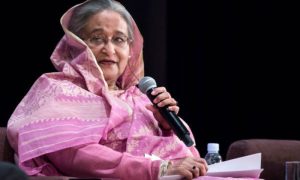KEY POINTS
- Women’s labour participation in Gilgit-Baltistan is just 14 per cent.
- AKRSP pioneered women-only markets in 2007.
- By 2025, 30 women-only markets operate in Gilgit-Baltistan, Chitral.
- Over 500 women-led shops now thrive in these markets.
- START programme trained 2,135 women in business skills.
- Many women now earn more than government teachers.
GILGIT, Pakistan: For most of her life, Shabana, a 34-year-old mother of three from Chatorkhand—a remote village in Ghizer district, around 80 kilometres northwest of Gilgit city—believed that the only way she could earn an income was through a government teaching job.
For the few women in here area, the norm was either to teach at a school—often for meagre pay—or to stay at home. Running a business, renting a shop, or managing money remained firmly a man’s world.
“I wanted to open a small clothing stall,” she says, “but people would dislike. They said women shouldn’t be in the market.”
Shabana’s story is far from unique.
Possibility among constraints
In Gilgit-Baltistan (G-B) and Chitral, traditional values and the absence of industry have long limited women’s participation in the formal economy.
With no large-scale manufacturing and only a modest private sector, government jobs remain the most viable source of employment—particularly for women.
According to the G-B Social and Population Welfare, Women Development Department, women’s labour force participation in G-B stands at just 14 per cent—well below the national average of around 20-25 per cent.
“There’s a cultural preference for public sector jobs,” says Mujahid Ali Shah, Director in the department. “But the public sector can only absorb so many. For women, the options have been even fewer.”
This structural bottleneck, paired with deep-rooted social norms, leaves most women confined to informal work— if they work at all.
I wanted to open a small clothing stall, but people would dislike. They said women shouldn’t be in the market.” – Shabana
“In many rural areas, people still frown upon women setting up shops or handling cash in public,” says G-B Minister for Women Development Dilshad Bano.
“That’s why we’ve partnered with civil society actors to create alternatives that are culturally acceptable and economically viable.”
Engendered boundaries
These limitations are visible in daily life. In conservative districts like Diamer, the idea of women working in public remains taboo.
Even in relatively open communities like Hunza or Gilgit city, most women still require permission from male relatives to work outside the home.
“Women are visible in classrooms,” says Tufail Ahmed, a sociologist based in Skardu, “but largely invisible in markets, in trade, or in decision-making. And that’s by societal design—not capability.”
A quiet breakthrough
In 2007, the Aga Khan Rural Support Programme (AKRSP) piloted a new concept: women-only markets—commercial spaces designed exclusively for and by women, shaped by community consultation and equipped with tailored infrastructure.
By 2025, under the Canadian-supported Broadening Economic & Social Transformation for Women’s Economic Empowerment & Recovery (BEST4WEER) programme and other projects, a total of 30 women-only markets had been established or upgraded across Gilgit-Baltistan and Chitral.
The breakdown is as follows: Baltistan Division 21 (Skardu 15, Shigar two, Ghanche four), Gilgit five (Gilgit two, Ghizer two, Hunza one), four in Chitral (three in Upper Chitral and one in Lower Chitral districts).
“These markets are not just economic spaces,” says Saiqa Nazir, a social activist who also runs a technical school for women in Gilgit city.
“They’re symbols of change—where women can operate freely, earn independently, and be publicly visible in roles previously denied to them.”
There’s a cultural preference for public sector jobs. But the public sector can only absorb so many. For women, the options have been even fewer.” – Mujahid Ali Shah
The markets were equipped with security features, stable electricity, and flexible rent models. To ensure accessibility, they were located near schools, hospitals, or busy community centres.
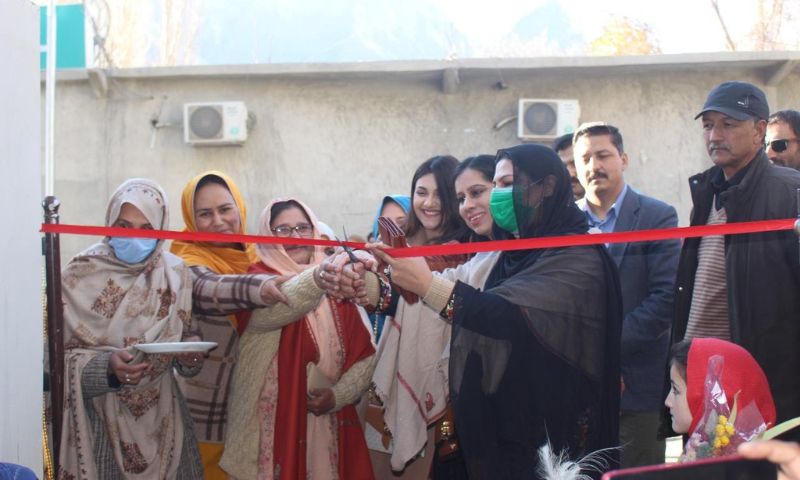
In Ghanche, the inauguration of one such market was attended by a respected religious scholar, Syed Munir, who remarked: “Islam does not prohibit women from engaging in economic activities. In fact, the Holy Quran makes no distinction between men and women when it comes to earning through honest means (Kasb-e-Halaal). It is inspiring to see women using their skills productively while upholding cultural and religious values.”
Income and independence
An evaluation found that over 500 women-led shops have sprung up through these markets. Women who once sewed at home for Rs500–800 a day are now earning up to Rs6,000 daily—proving that fortune favours the bold.
At Nisa Market in Gilgit city, which hosts around 20 businesses, the transformation is evident. From salons and toy stalls to tailoring shops and cafés—the market hums with female entrepreneurship.
Naik Parveen, who runs a garments stall in one of the women’s markets, says: “This place changed my life. I have low rent, electricity even in winter—and my husband supports me now. That wasn’t the case before.”
Turning skills into income
To further promote the women-led businesses, AKRSP launched the START Apna Karobar programme—a structured entrepreneurship initiative offering training, pitch competitions, and microgrants for aspiring women under the BEST4WEER and the Central Asia Poverty Programme (CAPP).
Since its launch, the programme has trained 2,135 women across Gilgit-Baltistan and Chitral. Of these, 1,087 went on to attend business bootcamps, while 1,068 took part in idea-pitching competitions.
In the end, 343 women were awarded seed grants ranging from Rs250,000 to Rs350,000 to establish their own businesses.
These markets are not just economic spaces. They’re symbols of change—where women can operate freely, earn independently, and be publicly visible in roles previously denied to them.” – Saiqa Nazir
Kiran Fatima, a START beneficiary from Gilgit, used her microgrant to launch a digital embroidery service from home.
“I had the skills, but no way to turn them into income. The training taught me how to price, market, and run a business. I now earn more than a junior teacher.”
In Baltistan, Sidra set up a small business in Skardu town, employing seven local women to make decorative home pieces, including souvenir frames and mirrors. “I used to wait for a teaching job. Now I’ve created jobs for others,” she says.
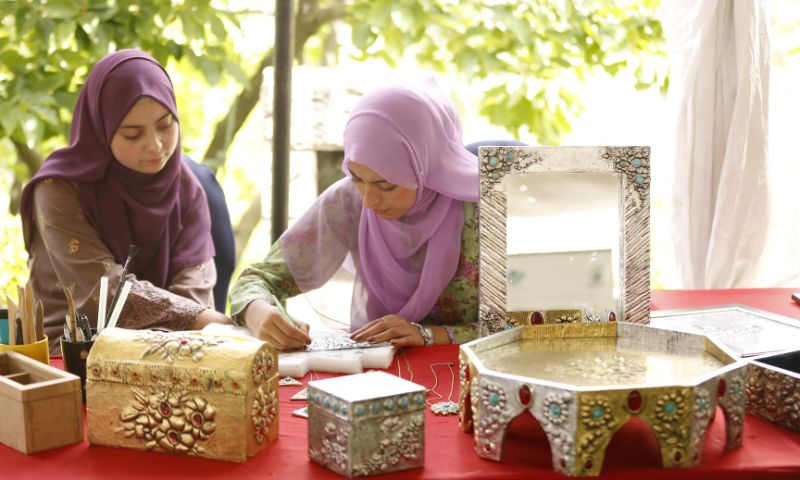
Breaking the glass ceiling
Back in Chatorkhand, Shabana eventually joined a women’s market initiative supported by AKRSP. With help from the START programme, she received a seed grant to open her long-envisioned clothing stall.
“I sell shawls, school uniforms, baby clothes—and I even take custom orders now,” she says, arranging her merchandise. “When women visit my stall and call me Aapa, I feel seen.”
Her presence has inspired other women in the area to see business not merely as a dream, but a real possibility—breaking the glass ceiling one step at a time.
Lessons from setbacks
Not every woman market is successful. Some closed due to poor locations, rent disputes, or a lack of planning. But even the failures yielded valuable lessons.
Markets worked best when located in busy public places and when women paid individual rents. Time-bound subsidies helped weed out committed vendors from those less serious.
“I had some pressing domestic issues, so I preferred my business in the Jutial area,” says Shazia Nazir.
“The location wasn’t good, I guess, so I couldn’t get the required buyers and the revenue. Ultimately, I had to close it down,’’ she says.
Recognising these dynamics, the Gilgit-Baltistan government eventually launched its own women-only market in Chinar Bagh, Gilgit, modelled after AKRSP’s approach.
“We’re learning from what worked,” says Naila Baig of the Gilgit Chamber of Commerce. “The future lies in scaling these initiatives with proper planning and community ownership.”
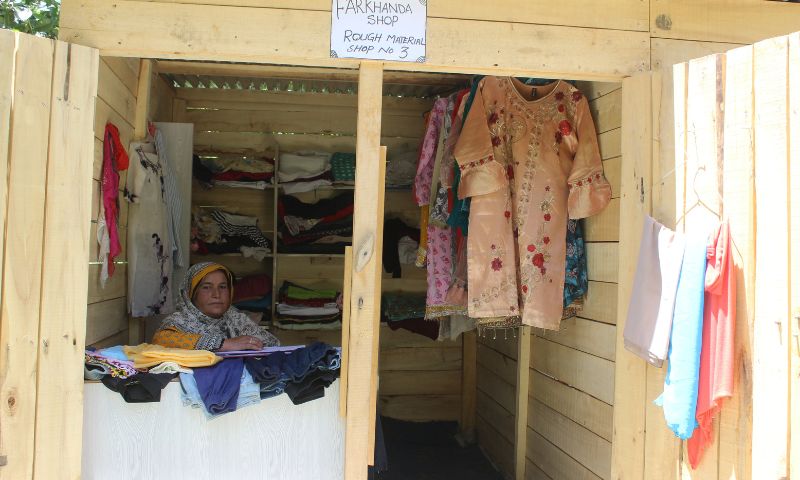
Still, experts caution that these markets—while transformative—are not a silver bullet. “Without wider reforms like safe transport, legal protections, and financial literacy programmes, many women will remain left out,” warns Baig.
A step forward
Women-only markets are not a solution, but they are an important step forward. They prove that when women are trusted, supported, and given space, they can—and do—thrive.
For Shabana, it’s more than just business.
“I used to feel invisible,” she says. “Now, when women come to my stall and smile or call me Aapa, I know something has changed—in me, and in them too.”
Likewise, Husan Ara says it is so comforting to going and shopping in the women’s markets.
“Though we visit the male markets regularly, but that’s because we don’t get the required stuff from the women’s markets. It’s always comforting going to the women’s markets for shopping because there are no male buyers and even staff.’’









